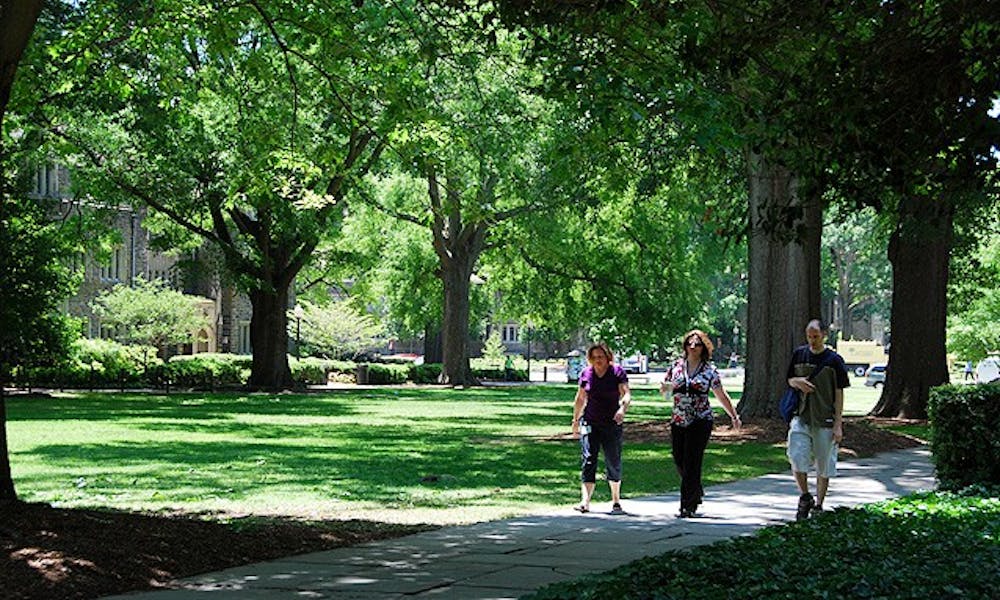The grass is always greener at Duke.
In an effort to preserve the beauty of campus quadrangles, Duke Facilities Management is reevaluating its methods for maintaining the grassy landscapes, an important aspect of Duke’s image. The University must balance aesthetic quality with the quads’ original purpose—student recreation—in order to provide students with a “backyard,” said Deb LoBiondo, assistant dean of Housing, Dining and Residence Life.
“It is awesome to see student interaction, but it’s hard to maintain the turf as a result,” said LoBiondo, who often organizes quad events. “You can’t really in any reasonable way say, ‘Go play somewhere else.’”
Facilities Management is implementing new lawn-keeping techniques, such as using compost to increase the grass’ fertility, working in larger sections, putting up more ropes and signs and restricting the use of vehicles on the lawns. The latter two decisions are part of a pact between Facilities Management and HDRL to protect the turf, said Joseph Jackson, director of grounds, sanitation and recycling for Facilities Management.
Restoration of the campus’ landscape is a continuous process that balances the agronomic requirements of grass and University activities held on the quad, Jackson said. Such restoration has been difficult because of the constant use of the quads—from K-ville camping and celebratory bonfires to fundraising activities and rallies.
In order to work around the ongoing activity, Jackson said Facilities Management tries to take advantage of lulls between events to work on the grounds. Jackson said this policy, however, has not been entirely effective because his team is unable to keep track of every event that utilizes the quads.
Jackson noted that some universities—including Southern Methodist University in Dallas, San Diego State University and Wake Forest University—are successful in keeping their lawns in pristine condition because they restrict people from even walking on the grass. That policy, though, is not an option at Duke, he added.
LoBiondo said she did not know yet how the new policy of limiting vehicle use on quads would affect events that involve food trucks, such as Joe College Day, which features musical performances in the Fall.
“We will, however, do our best to protect the turf and discourage trucks,” she said. “This may mean disallowing large trucks from driving on the lawn.”
LoBiondo added that preserving the quads require a cultural shift among departments and student groups who currently use the grassy areas liberally.
Working around events is not conducive to the seasonal requirements of the grass.
Jackson said the University primarily uses two types of grass—Fescue and Bermuda, which are planted according to microclimatic conditions. The turf-type Fescue grass, which stays green even in colder weather, is planted on the residential quads on West Campus, where large trees and buildings create shade. Bermuda grass, on the other hand, is better suited to more open and warmer places, such as East Campus and K-ville.
“We are fortunate to be living where grass grows throughout the year,” Jackson said.
Recent budget and water usage constraints also pose challenges to the maintenance staff.
Jackson said his office’s budget was affected by the economic downturn in 2008, though he noted that it did not greatly impact the level of maintenance. Although less prominent areas on campus saw less maintenance, quad areas were not affected.
The University also had to decrease the amount of water it used to maintain the grass in accordance with rules set by the city of Durham because of the ongoing drought in North Carolina.
The current irrigation system is outdated, Jackson said. His department has attempted to update it, but the system still breaks down occasionally. One problem, he noted, is that sensors measuring the amount of water in the grass can fail, causing sprinklers to turn on even when it is raining.
Jackson said he could not provide specific numbers about the current budget because the drought and economic downturn introduced particular variables that affected maintenance costs.
Despite the extensive challenges, maintaining campus aesthetics is important for Duke’s image, said Dean of Undergraduate Admissions Christoph Guttentag.
“Keeping the campus looking attractive is a good thing and appealing to the students,” Guttentag said. “In the 20 years I’ve been here, I’ve spoken with scores, if not hundreds, of students who have mentioned the beauty of the campus as one aspect that made Duke appealing for them.”
Get The Chronicle straight to your inbox
Sign up for our weekly newsletter. Cancel at any time.
There have not been any official figures confirming this trend, but discussions with people on campus led him to realize the importance of the campus’ appearance, Guttentag said. Guttentag noted that prospective students expect Duke to be particularly lush compared to some other institutions—such as those located in cities—and thus they are more perceptive to subpar grounds.
“If the campus doesn’t look nice, we hear about it,” he said.

